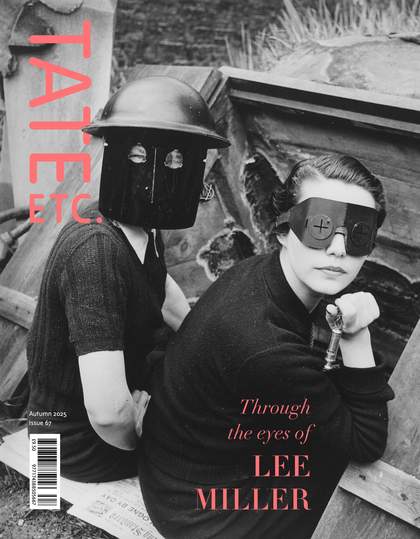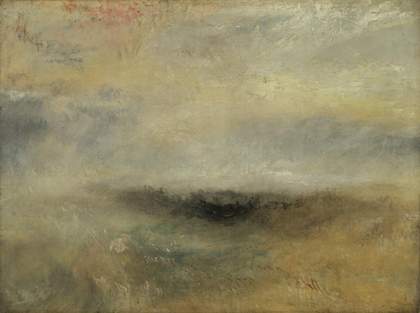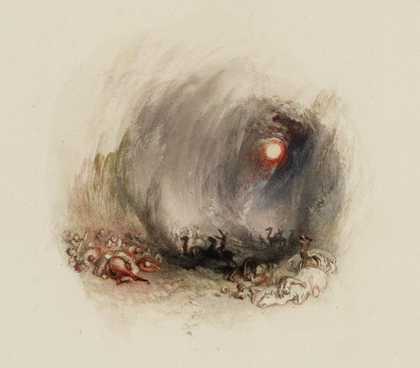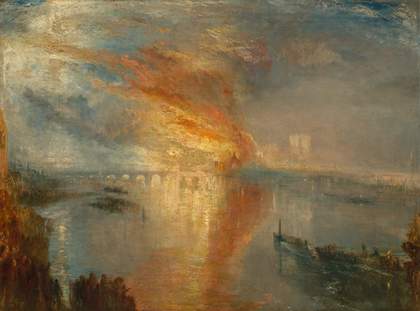
JMW Turner The Burning of the Houses of Lords and Commons, October 16,Ìý1834 1835 © Cleveland Museum of ArtÂ
FRANK BOWLING
I go to see Turner’s paintings all the time. Living where I do in Pimlico, I can walk around the corner to Tate Britain, take a quick look, and head back to my studio. Up close, you can see the brush marks – that he was pulling and dragging the paint to perform, physically engaging with it. This turmoil of beaten-up paint and colour is what I’m after in my own paintings as well. You see this way of working and can’t help but want to try it out yourself.
The sort of abstraction that you get with Turner is instinctive. I can see the magic – the freedom to put anything in there that you feel like. Working in the studio, you get this tense feeling and excitement. You don’t really want anyone else around. You feel your way, by yourself. I think Turner felt it too. His paintings come across as ‘felt’ – beyond just moulding the paint, kneading it back into that flat surface, his work went through his whole body. He had a feeling for paints; some people have it, and some people don’t.
Throughout my life, I have gone to look at Turner’s work as a corrective, to see if I’ve ‘got this’ – this way of hauling the paint or spreading paints one next to the other, risking this and that. I have been trying to find my own way of doing the same thing as him, grasping for a way to make the marks make sense.
Frank Bowling is an artist living in London. His painting Sacha Jason Guyana Dreams 1989 was purchased in 2006 and will be included in the free JMW Turner display in the Clore Gallery for the duration of the Turner and Constable exhibition. He talked to Amy Concannon, Manton Senior Curator, Historic British Art. This article has been edited from his contribution to the exhibition book published by Tate Publishing.
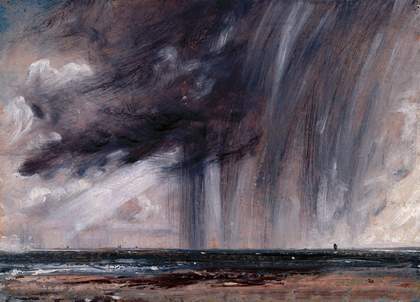
John Constable
Rainstorm over the Sea ³¦.1824–8
© Royal Academy of Arts, London. Photo: John Hammond
MAGGI HAMBLING
As a Suffolk child, my mother took me to Dedham, Flatford and East Bergholt, often pointing out the wrong cottage as ‘Willy Lott’s House’.* This in no way diminished my later lust for Constable’s PAINT. Paint that sinks your feet into mud, lifts your hand to sense the soft flesh of a carthorse, makes you feel the wind in your hair as it battles with black poplars, lets you witness the shadows of clouds as they pass over fields of corn.
Constable’s paint is as physical as Bacon’s in its thrust. With oil paint, a real artist can make you feel present, not only in a particular moment but in the creation of the work. Not for nothing did the French impressionists study Constable, who led them on in their search to render fleeting light and air.
Rainstorm over the Sea ³¦.1824–8 is electric in its drama – he stopped work at just the right moment – no tidying up – his human response to the elements is raw, forceful and timeless.
Constable’s ‘dome’ of the sky rises from the horizon, passes overhead and disappears behind you. He was in awe of the sky, in command as it is of everything beneath it, then and now.
*a building that appeared in several of Constable’s works
Maggi Hambling is an artist based in London and Suffolk. Her watercolours Sunrise 14.8.88 1988 and Sunrise 11.7.90 1990 were purchased in 1990 and will be included in the free John Constable display in the Clore Gallery from 13 October 2025 until the close of the Turner and Constable exhibition. Also in October, to celebrate her 80th birthday, a new monograph of Hambling’s art will be published by Rizzoli. The exhibition Maggi Hambling and Sarah Lucas runs at Sadie Coles HQ & Frankie Rossi Art Projects, London, 20 November 2025 – January 2026.
Turner and Constable: Rivals and Originals, Tate Britain, 27 November 2025 – 12 April 2026.
In partnership with LVMH. Supported by the Huo Family Foundation and James Bartos. With additional support from the Turner and Constable Exhibition Supporters Circle, Tate Americas Foundation and Tate Members. The media partner is The Times and The Sunday Times. Research supported by the Manton Historic British Art Scholarship Fund.

